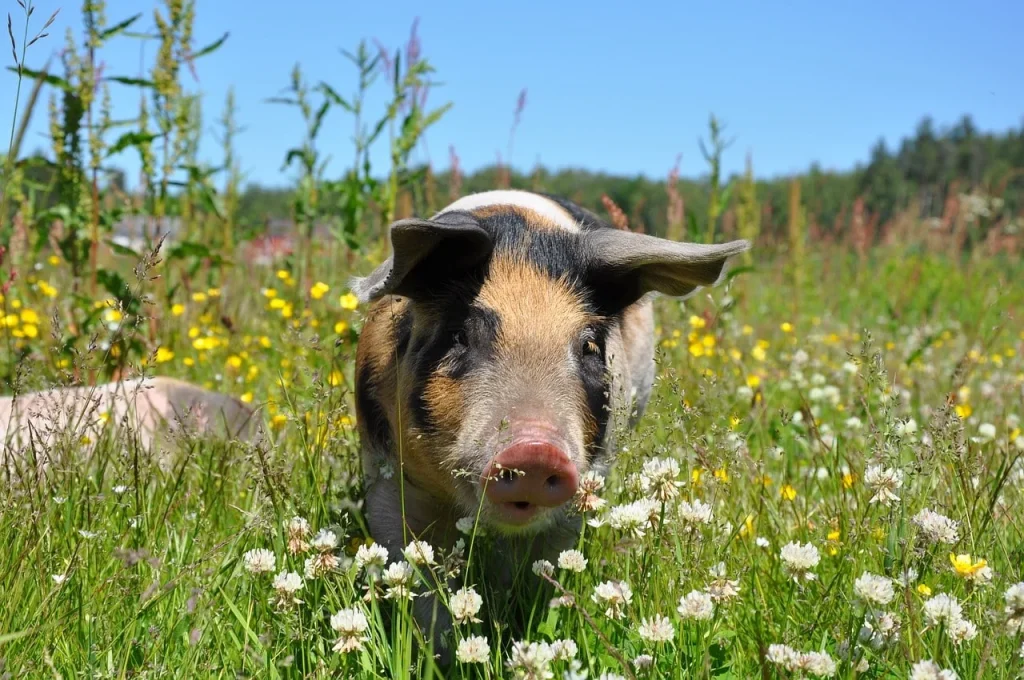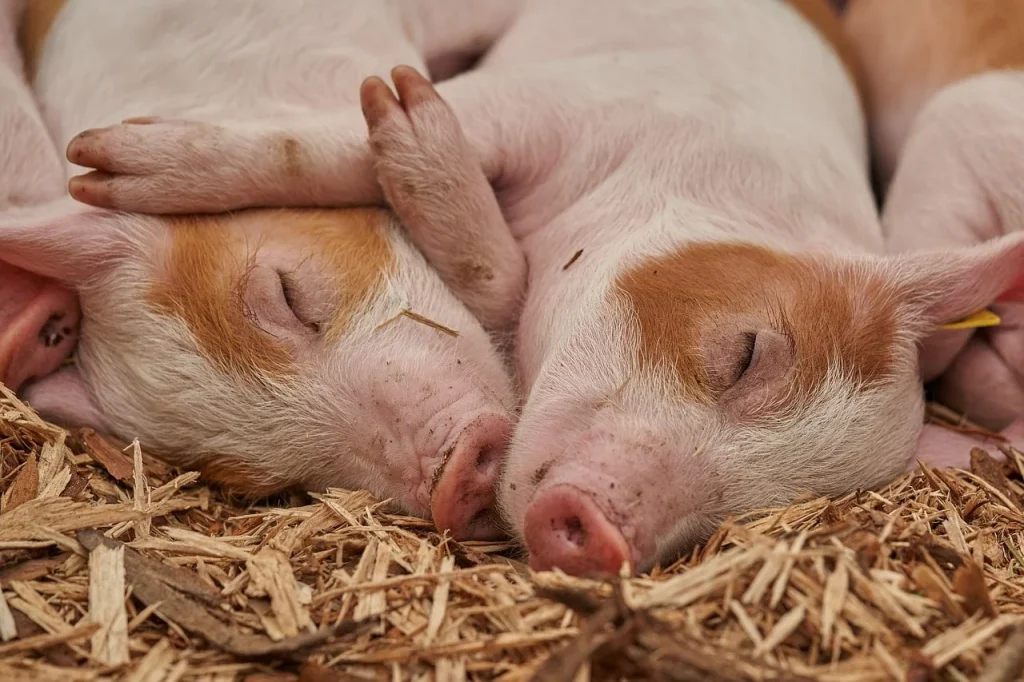Welcome to the world of pigs—creatures that are more than just fodder for funny cartoons and farmyard tales.
Did you know that pigs are some of the smartest animals on the planet? They can solve puzzles, play with toys, and even learn names faster than some of our pets at home!
Today, we’re diving snout-first into some interesting facts about these intelligent, curly-tailed characters. Have you ever seen a pig ‘smile‘ when they’re happy? Stick around, and you might just find out how!
I am fond of pigs. Dogs look up to us. Cats look down on us. Pigs treat us as equals.
Winston Churchill
Pigs Facts
Before we dive into the facts, prepare to put your knowledge to the test with our quiz at the end of this article. Read each fact carefully to prove your expertise on these intelligent creatures.
- Pigs are capable of playing video games with more success than some primates.
- These animals possess a remarkable sense of smell, detecting odors buried up to 25 feet underground.
- Their cardiovascular system is so similar to humans that their heart valves are used in human surgeries.
- Piglets learn their names by two to three weeks of age and respond when called.
- Sows sing to their young while nursing, possibly to enhance bonding.
- Their intelligence ranks higher than that of dogs and even some human children in certain tests, making them extraordinarily smart.
- Newborn piglets learn to run to their mothers’ voices and recognize their own names.
- They can dream, as evident from their REM sleep patterns.
- Their memory is impressive; they can remember objects several years after seeing them only once.
- A group of these animals is known as a drift or sounder.
- In ideal conditions, they can live for over 15 years.
- Contrary to popular belief, pigs prefer cleanliness and will not defecate near their living or eating areas if given a choice.
- Domesticated pigs are descended from wild boars and still share many of the same behaviors.

- They use more than 20 different vocalizations to communicate with each other.
- When not farmed, they can spend hours playing, sunbathing, and exploring.
- These creatures are capable of swimming and have been seen swimming over long distances in the wild.
- A pig can run a 7-minute mile if they are in shape.
- Their snouts are extremely sensitive and are used as a tactile tool.
- They are able to consume a wider range of foods than most other animals, including both plants and animal products.
- Pig insulin was used in medicine to treat human diabetes before synthetic alternatives were developed.
- They have an excellent sense of direction, finding their way home over large expanses of terrain.
- A mother pig builds a nest for her unborn piglets, meticulously choosing and carrying materials.
- In ancient cultures, they were often considered symbols of wealth and strength.
- Their whiskers, or vibrissae, are highly sensitive, helping them navigate and sense their surroundings.
- Rooting behavior is not just foraging—it also plays a role in communication and comfort.
- Some police departments use pigs instead of dogs due to their keen sense of smell.
- Their hooves are divided into four toes that help in soft soil traction.
- In some Asian countries, pigs are trained to dive from platforms into water as a tourist attraction.

- Teeth grinding is often used as a communication form among stressed individuals.
- Their tails can express their emotional state, much like dogs.
- Pigs do not have sweat glands, which is why they bathe in water or mud to cool down.
- Wallowing in mud also provides protection against sunburn and parasites.
- Julius Caesar famously decreed that pigs must be slaughtered humanely.
- In some parts of the world, a pig’s spleen is used to predict the weather.
- Historically, they were among the first animals to be domesticated, around 9,000 years ago in the Near East.
- Their trotters (feet) are considered a delicacy in many cuisines around the world.
- Biologically, they can donate blood to humans in emergency medical situations due to similar blood group substances.
- They have a complicated social structure, capable of forming close bonds with specific individuals.

- Wild species have been seen using tools, like sticks, to dig and find food.
- Their cognitive abilities enable them to manipulate objects with their snouts with precise control.
- A single pig can consume up to two pounds of raw meat per day.
- During World War II, rendered pig fat was an ingredient in the production of explosives.
- George Clooney famously kept a pet pig named Max for 18 years.
- In commercial settings, they can gain up to 10 pounds per week.
- Teacup pigs are a popular, though controversial, pet trend claiming to offer miniature versions of domestic pigs.
- Pig farming significantly contributes to methane emissions, a potent greenhouse gas.
- Their ability to adapt to varied environments is evident from their widespread global distribution.
- Bathing behaviors are often an indication of hierarchical structure within groups.
- In folklore and mythology, they are frequently depicted as symbols of prosperity and gluttony.
- Their ears are highly expressive and can indicate different emotional states or responses to environmental stimuli.
Pigs Myths

Now that we’ve explored all these fun facts about pigs, let’s dive into some common myths and set the record straight. It’s time to separate what’s true from what’s simply not.
- Pigs Are Dirty Animals
Contrary to popular belief, they are very clean. The mud baths they take are used for cooling down, as pigs lack sweat glands. A clean and dry environment is preferred by them whenever it’s available. - Pigs Eat Anything and Everything
They are indeed opportunistic eaters, but they thrive on a balanced diet. By caretakers, they are often fed a diet that includes grains, fruits, and vegetables to keep them healthy and well-nourished. - Pigs Are Not Intelligent
They are actually highly intelligent animals. Tasks can be learned quickly by them, and they are known for their problem-solving abilities, which are comparable to those of dogs and even some primates. - Pigs Cannot Be Trained
Training is very much possible with pigs. They can be taught to respond to their names and perform tricks, similar to dogs. Positive reinforcement methods are commonly used by trainers to achieve this. - Pigs Are Always Aggressive
Generally, they are gentle and social creatures. Aggression can be displayed if they feel threatened or are in pain, but by nature, they prefer peace and company, often showing affection to humans and other animals.
No products found.
Pigs Quotes

Pigs! We love their bacon, but what else? Check what others think with these funny, wise, and surprising quotes about everyone’s favorite farmyard friend.
Animals are my friends…and I don’t eat my friends.
George Bernard Shaw
George Bernard Shaw, a noted vegetarian and advocate for animal rights, emphasizes his philosophical stance against eating animals by equating them to friends, pigs included.
A pig resembles a saint in that he is more honored after death than during his lifetime.
Irma S. Rombauer
Irma S. Rombauer, author of ‘The Joy of Cooking‘, makes a wry observation about how pigs, much like revered figures, gain more appreciation posthumously, especially in culinary contexts.
The pig, if I am not mistaken, supplies us sausage, ham, and pork. In short, the pig is a real treasure of utility.
Plutarch
Plutarch, the ancient Greek biographer, offers a practical look at the pig, valuing it for its numerous contributions to human cuisine.
Never wrestle with pigs. You both get dirty and the pig likes it.
George Bernard Shaw
Once again, George Bernard Shaw provides a metaphorical take, this time warning against engaging in fruitless or lowly disputes, with a humorous nod to the pig’s contentment in messy situations.
No man should be allowed to be the President who does not understand hogs.
Harry Truman
Harry Truman uses this statement to underscore a down-to-earth, practical knowledge that he believed was essential for leadership, using the understanding of pigs as a metaphor for relatability and realism.
Pigs FAQ

Before you face the trivia, here’s a crucial FAQ section on pigs. Pay close attention if you want to ace the following quiz.
- Will pigs eat other pigs?
Although it’s quite rare, they can exhibit cannibalistic behavior under extreme conditions such as overcrowding, high stress, or lack of food. It’s not typical behavior and is usually a sign that their environment needs immediate improvement. - How do pigs mate?
They have a unique courtship process, often initiated by the male (boar), who exhibits behaviors like grunting and nudging to attract a female (sow). Mating can occur throughout the year, with the sow being receptive to the boar for a short period, typically every 21 days, unless she is pregnant. - Can pigs swim?
Yes, they are actually quite good swimmers! They are known to enjoy water and can swim when they have access to a body of water. Swimming is a natural behavior that helps them cool off and relax. - Why do pigs like mud?
Pigs roll in mud to cool off because they lack enough sweat glands to regulate their body temperature through sweating. The mud not only cools them down but also provides a protective layer against the sun and parasites. - Can pigs eat chocolate?
While they can physically consume chocolate, it’s not recommended as part of their diet. Chocolate contains theobromine, which can be toxic to pigs (and many other animals) in large amounts. It’s best to stick to their regular, nutritionally balanced pig feed.
No products found.
Pigs Trivia

Welcome to our pig-themed quiz! Remember, if you can’t get any answers right, you might just end up as the pig’s dinner instead!
Pigs Merch
If you are a true fan of pigs, then you definitely need to check out our merchandise. You can find T-shirts, hoodies, mugs, and tote bags for your favorite designs. Feel free to check out all the other designs in our shop.
Conclusion
Looking back on all the pig facts we’ve covered, it’s clear that pigs are more than meets the eye. They have complex behaviors, deep social interactions, and intelligence that rivals that of dogs.
It’s important to see pigs as the smart and sentient beings they are, deserving of humane treatment and consideration. Till next time, stay curious and explore more. Cheers.


